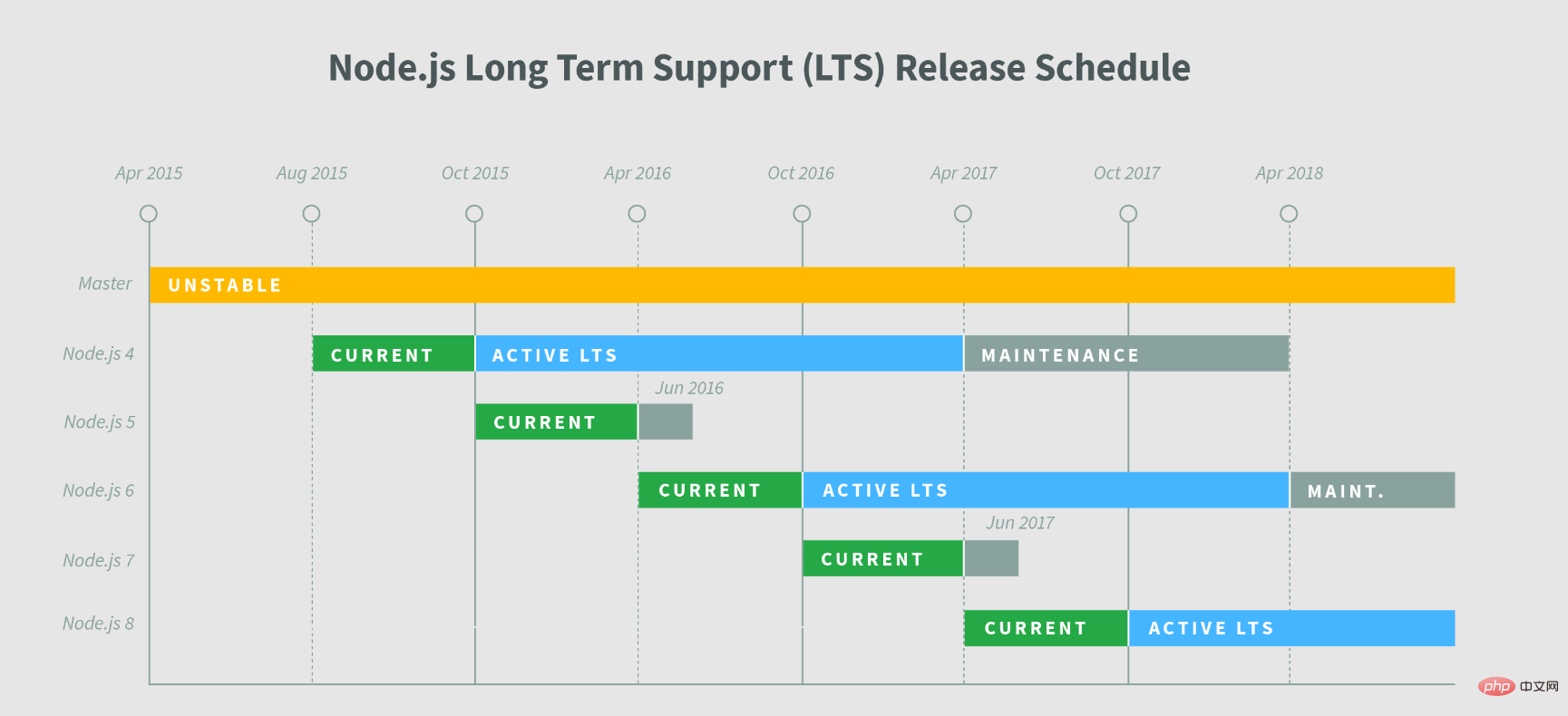In nodejs, lts means long-term support and is the abbreviation of "Long Time Support"; Node has two release process lines, odd version and even version. When an odd version is released, the latest even version will immediately enter LTS maintenance. The plan lasts for 18 months, and there will be an extended maintenance period of 12 months after that. During the LTS period, "bug fix" changes can be supported.

The operating environment of this article: Windows 10 system, nodejs version 12.19.0, Dell G3 computer.
LTS stands for Long Time Support, which means long-term support.
LTS: long-term support version, stable
Current: latest version
Node maintains two release pipelines: odd-numbered versions are released in October every year, and even-numbered versions are released in April of the following year.

When an odd-numbered version is released, the latest even-numbered version will immediately enter the LTS maintenance plan, which will last for 18 months. There will then be an extended maintenance period of 12 months. The changes that can be supported during these two periods are different:
Changes supported during the LTS period: bug fixes, security issue fixes, documentation updates and updates for compatibility issues with future new features.
Changes supported during Maintenance: Serious bug fixes, serious security issue fixes or documentation updates.
When an even-numbered version is released, the odd-numbered version only has a 2-month maintenance period and can only be upgraded obediently.
To sum up:
Based on minor version upgrades, LTS and Maintenanece versions do not have radical new feature updates and are more suitable for production environments. The regression workload and risk of upgrading minor versions will be much smaller. Based on major version number upgrades, LTS and Maintenanece versions have a long maintenance life cycle and do not need to upgrade the main version number frequently. This is not the case for odd-numbered versions, which usually have to be upgraded once every six months.
Expand your knowledge:
Node.js LTS Plan
After the merger of Node.js and io.js, Node.js core began to use LTS (Long Term Support) to plan the release cycle in order to ensure stable and orderly releases and allow developers to reasonably arrange upgrades. The first LTS version was v4, released in October 2015.
Under this plan, the version of Node.js is equivalent to a snapshot of the master branch that has been stabilized at a specific time. When the time is up, the stable parts of the master branch will be integrated and a new version will be released. Therefore, the release of Node.js is Based on the passage of time, the version jump is based on the premise of ensuring close compatibility, rather than on the number of compatibility and new features. This also explains why the version of Node.js seems to jump so fast (not " Ah, we have saved so many big moves, we can release a new version!" but "Ah, it's time to release the new version in April. Let's go through the big moves we have saved and see if there are any that are stable enough to be added. These tricks are not that big...").
It is worth mentioning that the current evergreen browsers/mainstream JavaScript engines/ECMAScript standards/C++ standards also adopt similar principles, taking the time span as the benchmark and intercepting stable features from the backbone for release.
Each LTS will have a code name, take the element name from the periodic table, sort it alphabetically, and select the appropriate one. The code name of v4 is Argon (argon), and the code name of v6 is Boron (boron).
The version naming rules of Node.js follow Semantic Versioning. The version number is divided into three parts. The first number (semver-major) increases, indicating incompatible changes; the second number (semver-minor) An increase indicates that there are new features that maintain compatibility; an increase in the third number (semver-patch) indicates that there are changes while maintaining compatibility and features, such as fixing bugs or improving documentation. This naming rule has advantages and disadvantages, which will not be described here. However, some of its contradictions make some exceptions to the naming of Node.js. For example, even if a security update causes incompatibility, in order to be able to update to all major versions, it is still semver. -minor.
Recommended learning: "nodejs video tutorial"
The above is the detailed content of what lts means in nodejs. For more information, please pay attention to other related articles on this site!